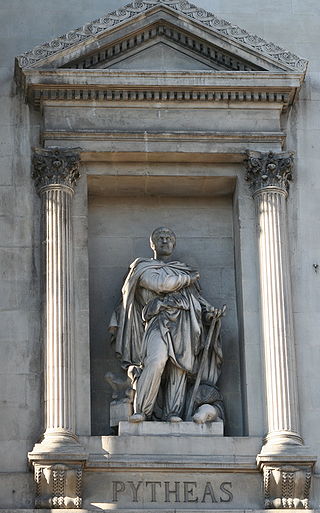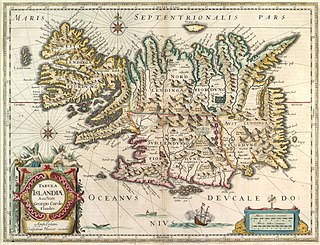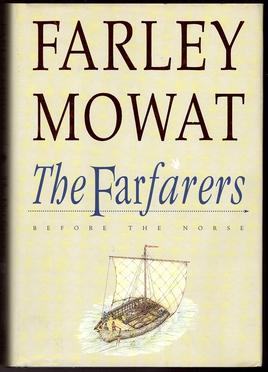In grammar, the dative case is a grammatical case used in some languages to indicate the recipient or beneficiary of an action, as in "Maria Jacobo potum dedit", Latin for "Maria gave Jacob a drink". In this example, the dative marks what would be considered the indirect object of a verb in English.

Greenland is a North American autonomous territory of the Kingdom of Denmark. It is the largest autonomous territory within the Kingdom and one of two such territories within the Kingdom, the others being the Faroe Islands; the citizens of both territories as well as Denmark proper are all citizens of Denmark. As Greenland is one of the Overseas Countries and Territories of the European Union, citizens of Greenland are European Union citizens. The capital and largest city of Greenland is Nuuk. Greenland lies between the Arctic and Atlantic oceans, east of the Canadian Arctic Archipelago. It is the world's largest island, as well as the northernmost area of the world – Kaffeklubben Island off the northern coast is the world's northernmost undisputed point of land, and Cape Morris Jesup on the mainland was thought to be so until the 1960s.

Pytheas of Massalia was a Greek geographer, explorer and astronomer from the Greek colony of Massalia. He made a voyage of exploration to northwestern Europe in about 325 BC, but his account of it, known widely in antiquity, has not survived and is now known only through the writings of others.

The history of Greenland is a history of life under extreme Arctic conditions: currently, an ice sheet covers about eighty percent of the island, restricting human activity largely to the coasts.

The recorded history of Iceland began with the settlement by Viking explorers and the people they enslaved from Western Europe, particularly in modern-day Norway and the British Isles, in the late ninth century. Iceland was still uninhabited long after the rest of Western Europe had been settled. Recorded settlement has conventionally been dated back to 874, although archaeological evidence indicates Gaelic monks from Ireland, known as papar according to sagas, may have settled Iceland earlier.

Evia also known by its antique spelling Euboea is the second-largest Greek island in area and population, after Crete, and the sixth largest island in the Mediterranean Sea. It is separated from Boeotia in mainland Greece by the narrow Euripus Strait. In general outline it is a long and narrow island; it is about 180 km (110 mi) long, and varies in breadth from 50 km (31 mi) to 6 km (3.7 mi). Its geographic orientation is from northwest to southeast, and it is traversed throughout its length by a mountain range, which forms part of the chain that bounds Thessaly on the east, and is continued south of Euboia in the lofty islands of Andros, Tinos and Mykonos.

The League of Corinth, also referred to as the Hellenic League, was a federation of Greek states created by Philip II in 338–337 BC. The League was created in order to unify Greek military forces under Macedonian leadership (hegemony) in their combined conquest of the Persian Achaemenid Empire.

In Greek mythology, the Hyperboreans were a mythical people who lived in the far northern part of the known world. Their name appears to derive from the Greek ὑπέρ Βορέᾱ, "beyond Boreas", although some scholars prefer a derivation from ὑπερφέρω.

Thule is the most northerly location mentioned in ancient Greek and Roman literature and cartography. Modern interpretations have included Orkney, Shetland, Northern Scotland, the island of Saaremaa (Ösel) in Estonia, and the Norwegian island of Smøla.

Pituffik Space Base, formerly Thule Air Base, is the United States Space Force's northernmost base, and the northernmost installation of the U.S. Armed Forces, located 750 mi (1,210 km) north of the Arctic Circle and 947 mi (1,524 km) from the North Pole on the northwest coast of the island of Greenland. Pituffik's Arctic environment includes icebergs in North Star Bay, two islands, a polar ice sheet, and Wolstenholme Fjord – the only place on Earth where four active glaciers join together. The base is home to a substantial portion of the global network of missile warning sensors of Space Delta 4, and space surveillance and space control sensors of Space Delta 2, providing space awareness and advanced missile detection capabilities to North American Aerospace Defense Command (NORAD), the United States Space Force, and joint partners.

Helluland is the name given to one of the three lands, the others being Vinland and Markland, seen by Bjarni Herjólfsson, encountered by Leif Erikson and further explored by Thorfinn Karlsefni Thórdarson around AD 1000 on the North Atlantic coast of North America. As some writers refer to all land beyond Greenland as Vinland, Helluland is sometimes considered a part of Vinland.

The Farfarers: Before the Norse is a non-fiction book by Farley Mowat, setting out a theory about pre-Columbian trans-oceanic contact. Mowat's thesis is that before the Vikings, North America was discovered and settled by Europeans from Orkney. They reached Canada after a generation-spanning migration that used Iceland and Greenland as 'stepping stones'. Mowat's ideas are controversial and have been accused of being over-speculative. The book has been published in the UK as The Alban Quest.
The Tsamikos or Kleftikos is a popular traditional folk dance of Greece, done to music of 3/4 meter.

The settlement of Iceland is generally believed to have begun in the second half of the ninth century, when Norse settlers migrated across the North Atlantic. The reasons for the migration are uncertain: later in the Middle Ages Icelanders themselves tended to cite civil strife brought about by the ambitions of the Norwegian king Harald I of Norway, but modern historians focus on deeper factors, such as a shortage of arable land in Scandinavia. Unlike Great Britain and Ireland, Iceland was unsettled land and could be claimed without conflict with existing inhabitants.

Derbe or Dervi, also called Derveia, was a city of Galatia in Asia Minor, and later of Lycaonia, and still later of Isauria and Cappadocia. It is mentioned in the Acts of the Apostles at 14:6, 14:20, 16:1 and 20:4. Derbe is the only city mentioned in the New Testament where the message of the Gospel was accepted from the beginning by its inhabitants.

The toponym "British Isles" refers to a European archipelago comprising Great Britain, Ireland and the smaller, adjacent islands. The word "British" has also become an adjective and demonym referring to the United Kingdom and more historically associated with the British Empire. For this reason, the name British Isles is avoided by some, as such usage could be misrepresented to imply continued territorial claims or political overlordship of the Republic of Ireland by the United Kingdom.
The name Britain originates from the Common Brittonic term *Pritanī and is one of the oldest known names for Great Britain, an island off the north-western coast of continental Europe. The terms Briton and British, similarly derived, refer to some or all of its inhabitants and, to varying extents, those of the smaller islands in the vicinity. "British Isles" is the only ancient name for these islands to survive in general usage.

Arctic exploration is the physical exploration of the Arctic region of the Earth. It refers to the historical period during which mankind has explored the region north of the Arctic Circle. Historical records suggest that humankind have explored the northern extremes since 325 BC, when the ancient Greek sailor Pytheas reached a frozen sea while attempting to find a source of the metal tin. Dangerous oceans and poor weather conditions often fetter explorers attempting to reach polar regions, and journeying through these perils by sight, boat, and foot has proven difficult.

Herjolfsnes was a Norse settlement in Greenland, 50 km northwest of Cape Farewell. It was established by Herjolf Bardsson in the late 10th century and is believed to have lasted some 500 years. The fate of its inhabitants, along with all the other Norse Greenlanders, is unknown. The site is known today for having yielded remarkably well-preserved medieval garments, excavated by Danish archaeologist Poul Nörlund in 1921. Its name roughly translates as Herjolf's Point or Cape.

Vatnahverfi was a district in the Norse Greenlanders’ Eastern Settlement (Eystribyggð) and is generally regarded by archaeologists and historians as having the best pastoral land in the colony. The Norse settled Vatnahverfi in the late 10th century and farmed there for nearly 500 years before mysteriously disappearing from the district and the entirety of Greenland, likely at some point in the latter 15th century. Its name is roughly translated as “Lake District."

















